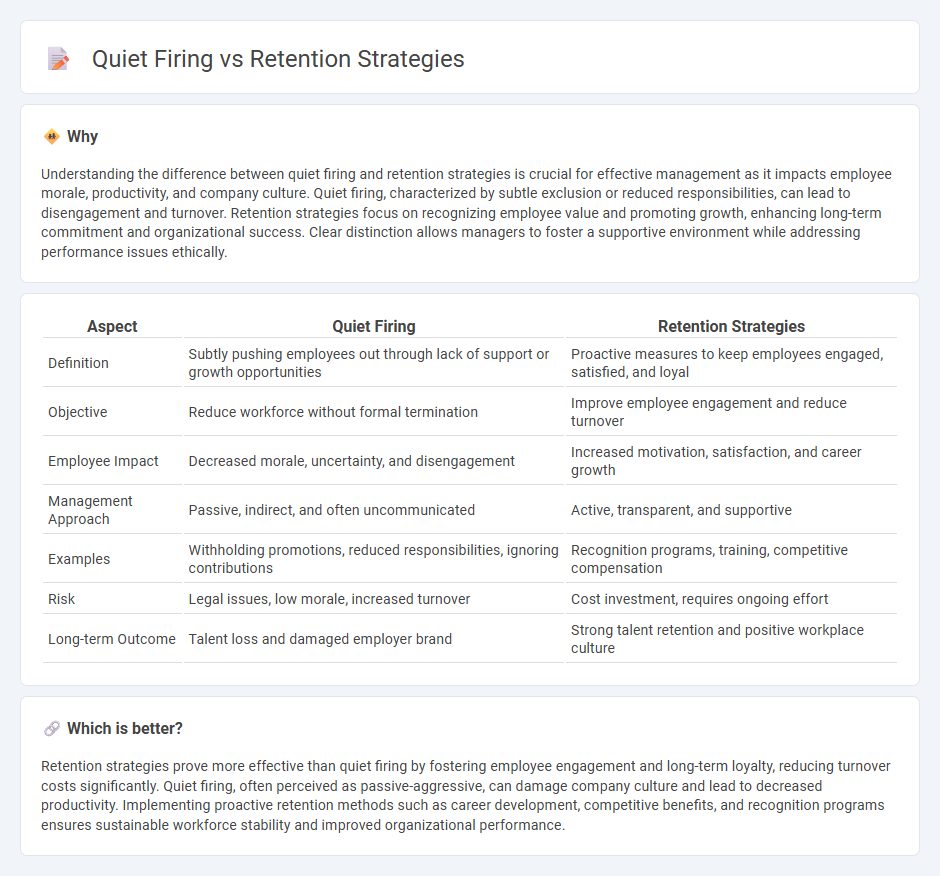
Quiet firing involves subtly encouraging employees to leave without formal termination, often through reduced responsibilities or exclusion. In contrast, retention strategies focus on actively engaging and motivating employees to stay by enhancing job satisfaction and career development opportunities. Discover effective approaches to balance workforce stability and productivity by exploring these management tactics in depth.
Why it is important
Understanding the difference between quiet firing and retention strategies is crucial for effective management as it impacts employee morale, productivity, and company culture. Quiet firing, characterized by subtle exclusion or reduced responsibilities, can lead to disengagement and turnover. Retention strategies focus on recognizing employee value and promoting growth, enhancing long-term commitment and organizational success. Clear distinction allows managers to foster a supportive environment while addressing performance issues ethically.
Comparison Table
| Aspect | Quiet Firing | Retention Strategies |
|---|---|---|
| Definition | Subtly pushing employees out through lack of support or growth opportunities | Proactive measures to keep employees engaged, satisfied, and loyal |
| Objective | Reduce workforce without formal termination | Improve employee engagement and reduce turnover |
| Employee Impact | Decreased morale, uncertainty, and disengagement | Increased motivation, satisfaction, and career growth |
| Management Approach | Passive, indirect, and often uncommunicated | Active, transparent, and supportive |
| Examples | Withholding promotions, reduced responsibilities, ignoring contributions | Recognition programs, training, competitive compensation |
| Risk | Legal issues, low morale, increased turnover | Cost investment, requires ongoing effort |
| Long-term Outcome | Talent loss and damaged employer brand | Strong talent retention and positive workplace culture |
Which is better?
Retention strategies prove more effective than quiet firing by fostering employee engagement and long-term loyalty, reducing turnover costs significantly. Quiet firing, often perceived as passive-aggressive, can damage company culture and lead to decreased productivity. Implementing proactive retention methods such as career development, competitive benefits, and recognition programs ensures sustainable workforce stability and improved organizational performance.
Connection
Quiet firing, where employers subtly encourage underperforming employees to leave, directly impacts retention strategies by influencing workplace morale and employee engagement levels. Effective retention strategies counteract quiet firing effects through targeted career development programs, transparent communication, and fostering a positive organizational culture to maintain talent. Data shows companies with strong retention efforts experience lower turnover rates and higher employee satisfaction, mitigating the risks associated with quiet firing practices.
Key Terms
**Retention Strategies:**
Retention strategies prioritize employee engagement, career development, and positive workplace culture to reduce turnover and enhance productivity. Techniques such as competitive compensation, recognition programs, and opportunities for growth foster loyalty and job satisfaction. Discover more effective retention strategies to build a committed and motivated workforce.
Employee Engagement
Retention strategies prioritize boosting employee engagement through clear communication, career development opportunities, and recognition programs to foster long-term commitment and reduce turnover rates. In contrast, quiet firing subtly disengages employees by withholding support, growth opportunities, or feedback, leading to decreased morale and eventual exit. Explore effective approaches to enhance employee engagement and avoid the pitfalls of quiet firing.
Career Development
Retention strategies emphasize career development by offering employees clear growth paths, skill-building opportunities, and regular feedback to enhance job satisfaction and loyalty. Quiet firing, conversely, subtly limits career advancement and withholds professional development, leading to disengagement and increased turnover risk. Explore effective career development tactics to improve retention and prevent quiet firing consequences.
Source and External Links
15 employee retention strategies to keep talent | Achievers - Key strategies include building employee engagement, providing recognition and rewards, and recruiting employees who fit the company culture to improve retention and prevent productivity loss.
Customer retention: Metrics, strategies, and examples - Zendesk - Effective retention strategies involve incentivizing loyalty through loyalty programs, referral programs, and creating a positive employee experience to boost customer loyalty and reduce employee turnover.
14 Effective Employee Retention Strategies - Robert Half - Emphasizes onboarding, mentorship programs, fair compensation, and perks as essential steps for setting employees up for long-term success and satisfaction, which enhance retention.
 dowidth.com
dowidth.com